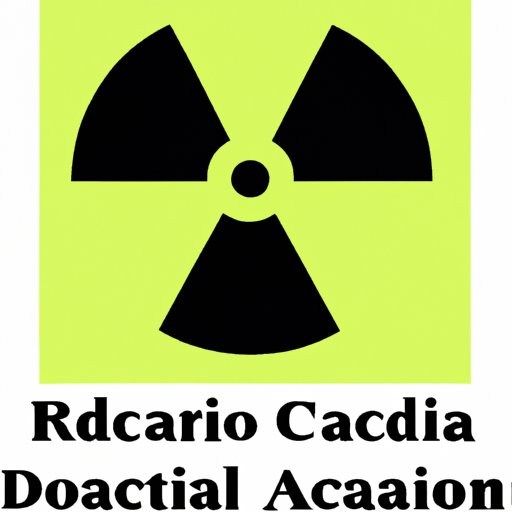I. Introduction
Have you ever wondered what radioactivity is and why it matters? The truth is, radioactivity is a fascinating but potentially dangerous phenomenon that is present in many aspects of our lives, from medical imaging to nuclear power generation. It is essential to understand what radioactivity is, how it works, its history, and its various applications and effects. This article will provide a comprehensive overview of radioactivity, focusing on defining radioactivity, its history, the effects of exposure, its current applications, and its future.
II. Defining Radioactivity
Radioactivity refers to the property of certain elements to emit ionizing radiation as their nuclei undergo decay, leading to the formation of new elements and isotopes. This phenomenon occurs spontaneously and unpredictably, and the radiation can be harmful to living organisms. Radioactivity is usually measured in becquerels (Bq) or curies (Ci), which are units of radioactivity output or decay rate per second or per gram of substance.
Radioactive isotopes can occur naturally, such as in rocks and cosmic rays, or through human-made reactions, such as nuclear fission or fusion. The most common types of radiation emitted from radioactive isotopes are alpha particles, beta particles, and gamma rays. Alpha particles are positively charged and have low penetrating power, while beta particles are negatively charged and can penetrate through clothing and skin. Gamma rays are highly penetrating and require thick shielding to block them.
Common examples of radioactive materials include uranium, radium, thorium, and isotopes of carbon, iodine, and cesium. These materials can be found in various sources, such as soil, rocks, water, and industrial waste. Some radioactive materials, such as radioactive gases, can enter the environment and be transported long distances through wind or water.
Radioactive materials can be used for various purposes, such as medical diagnosis and treatment, industrial applications, and power generation. However, they also pose risks to human health and the environment if not handled properly.
III. The History of Radioactivity
The discovery of radioactivity dates back to the late 19th century when French physicist Henri Becquerel accidentally discovered that uranium salts emit rays that can expose photographic plates. This discovery led to the further study of radioactivity by other physicists, such as Marie and Pierre Curie, who coined the term “radioactivity” and discovered new radioactive elements, such as radium and polonium.
Soon after, other major breakthroughs followed, such as the development of the Geiger-Müller counter to detect radiation, the discovery of artificial radioisotopes through nuclear reactions, and the development of nuclear fission, which led to the creation of the atomic bomb and nuclear power generation.
Our understanding of radioactivity has evolved over time, and more research is needed to continue to expand our knowledge about this phenomenon fully.
IV. The Effects of Radioactive Exposure
Exposure to radioactive materials can have both short-term and long-term effects on human health and the environment. Short-term effects may include radiation sickness, which can cause symptoms such as nausea, vomiting, and hair loss. Long-term health risks may include cancer, genetic mutations, and other chronic diseases.
Environmental impacts can also result from radioactive exposure, such as contamination of soil and water, which can affect wildlife and the food chain. Radioactive materials can persist in the environment for years or even centuries, posing risks to future generations.
V. Current Applications of Radioactivity
Radioactivity has various applications in different fields, such as nuclear power generation, medical imaging and treatment, and industrial applications. Nuclear power generation involves using nuclear reactors to produce electricity, which is a reliable and relatively clean source of energy. Medical imaging and treatment involve using radioactive isotopes to visualize and treat disease in the body, such as in PET scans or radiation therapy. Industrial applications of radioactivity include measuring the thickness and composition of materials, testing for quality control, and detecting flaws in metal work.
However, these applications also raise concerns about safety, security, and environmental protection, as the consequences of accidents or misuse can be severe. Radiation leaks or contamination can have a significant impact on public health and the environment, as seen in disasters such as Chernobyl and Fukushima.
VI. The Future of Radioactivity
Research and development in the field of radioactivity continue to advance, with new technologies and discoveries being made in areas such as nuclear medicine, waste management, and nuclear fusion. Nuclear medicine, for instance, is exploring promising new treatments for cancer and other diseases by targeting specific cells with radioactive isotopes. Waste management is working to develop better methods of storing and disposing of radioactive materials, while nuclear fusion research seeks to find new ways of producing clean energy without the risks of nuclear fission.
Nevertheless, questions remain about the safety and sustainability of these new technologies, and ongoing research and public engagement are critical to ensure that the benefits of radioactivity are maximized while minimizing harmful impacts.
VII. Conclusion
In conclusion, radioactivity is a fascinating but complex phenomenon that has both potential benefits and risks. It is crucial to understand what radioactivity is, how it works, its history, its effects, its current applications, and its future to mitigate these risks and make informed decisions about our interactions with radioactive materials. We must continue to support research and development in this field to ensure that we harness the benefits of radioactivity while minimizing its negative impact on our health and the environment.
Let us all stay informed, safe, and involved in the ongoing conversation about radioactivity, its applications, and potential impacts.
